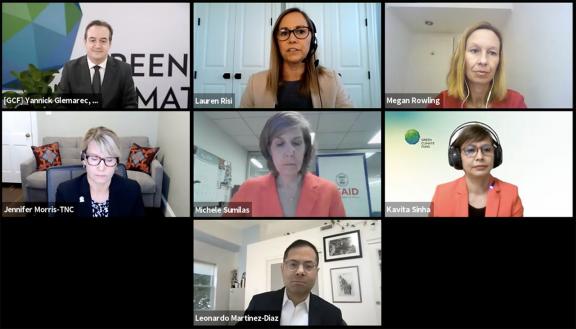On 18 May 2021, the Wilson Center organized a discussion focused on the role of the Green Climate Fund in scaling up finance for climate action. Ambassador Mark Green, the President of the Wilson Center, opened the discussion with a call to action : “the climate crisis is already here, and so is our opportunity to respond. The world will face huge costs in adapting to climate change, up to $500 billion per year by 2050.” He then raised the biggest unanswered question in climate finance : why does adaptation currently attract only 20% of all climate finance?
The GCF’s Executive Director, Yannick Glemarec, emphasized : “Climate impacts are materializing faster than expected. GCF was established to promote a paradigm shift in our fight against climate change. We are the largest dedicated climate fund supporting developing countries and the GCF accounted for two thirds of all multilateral climate finance last year. Half of our resources are allocated to adaptation – and over two thirds of our adaptation funding go to the poorest and most vulnerable countries in the world.”
However, he also noted the urgent need for reducing climate emissions : “Over 120 countries responsible for over 60% of emissions have adopted or are considering net zero targets. These net-zero targets have put the Paris Agreement’s goals within striking distance. The two objectives are equally important. We must scale up both climate mitigation and adaptation efforts to address the climate crisis.”
Dr Glemarec identified four different ways in which GCF is scaling up for more climate action : supporting developing countries to turn their NDCs into investment plans; de-risking technological innovation and technology transfer to developing countries; making blended finance work better for adaptation and nature-based solutions; and strengthening the capacities of national banks and entrepreneurs to invest in providing commercially attractive climate innovations, products and services.
An expert panel, facilitated by Megan Rowling of Reuters Thompson News, then discussed and debated the opportunities for scaling up climate action. Leo Martinez, who advises the US Climate Envoy John Kerry, pointed out that the USA is now back in support of climate action : “We have announced our new NDC, and we will seek to double our climate finance by 2024 and triple our financing for adaptation. For 2022 we are requesting $1.25 billion to contribute to the GCF. I served as the US Representative to the GCF Board in the early years, and I think the US can come back and make a major contribution.”
He added that many countries are still struggling to understand the climate risks they face, but that GCF helps countries to quantify those risks, to use models and data that make the climate risks real : “If you can see it, you can manage it… GCF isn’t just a fund that provides investment, it also helps to articulate climate plans by engaging the member countries in ways that other institutions aren’t able to do. This is why GCF is an essential part of the climate sector.”

Other panellists and speakers included Jennifer Morris, CEO of The Nature Conservancy, who stressed the critical roles of nature-based solutions, such as conserving forests and soils, both for reducing carbon emissions and boosting adaptation; Kavita Sinha, Deputy Director for Mitigation at GCF, who said that GCF has found multiple ways of attracting new climate capital, using its various financial instruments to address the various types of risk associated in investing in developing countries, without creating additional burden on already burdened economies; and Michele Sumilas of USAID, who announced USAID’s new strategy to be unveiled at COP26, which will be mainstreaming climate into all aspects of their funding to developing countries, and looked forward to partnering and co-investing with GCF.